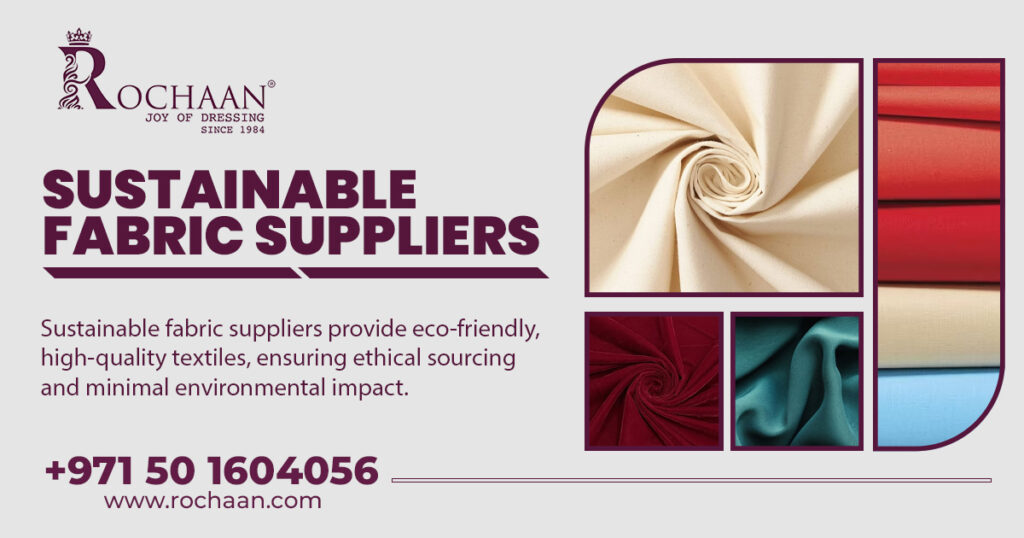Generally associated with glamour and modern designs, the fashion industry has major adverse environmental effects. Conventional fabric manufacture, which uses excessive water and produces harmful chemicals, has long worsened ecological degradation.
However, the shift to sustainable fabric offers a bright remedy. As thousands of businesses switch to sustainable textiles, others have likely been inspired to act as well. Going sustainable has many more benefits than you think. From saving the environment to your skin, they are full of merits over artificial fibre.
Therefore, choosing sustainable textiles should be a top focus for someone involved in fabrics. These fabrics are consumed in fashion, furniture design, or any other business. The brief guide below describes sustainable materials and why they are the future.

What is a sustainable fabric?
In simple terms, sustainable fabrics are materials and textiles designed to minimize their negative environmental impact. The brutal reality is that harmful processes have been in practice since the Industrial Revolution. Regarding textiles, the direct application of synthetic materials has significantly added to the planet’s current challenges.
Sustainable fabric harms society and the environment less or not at all. It is usually made from recycled or natural materials. While there is no cent percent sustainable material, a less percent of synthetic material can make a difference. Moreover, making better fabric selections will have short-term and long-term advantages.
The positive effects of choosing eco-friendly and sustainable fabrics
Sustainable and environmentally friendly textiles are highly good for people and the environment. Some of the major benefits are:
1. Less influence on the environment
Using sustainable and eco-friendly materials is one of the textile industry’s biggest benefits. It can decrease the negative effects it has on the environment. Leading the charge in the sustainable textiles movement, sustainable textiles serve as a model for others to imitate. These fabrics give priority to ethical practices and rigorous adherence to environmental norms. Their attention to the full supply chain from sourcing to disposal guarantees a favourable effect on society and the environment.
2. Lesser carbon footprint
The capacity of sustainable fabric to lower carbon emissions is one of its biggest benefits. Because traditional textiles heavily rely on fossil fuels, they have high carbon emissions. It is more effective when produced with synthetic fibers like polyester.
However, sustainable materials don’t use much energy as they are produced via renewable resources.
3. Safe for people’s health
Those with severe skin sensitivity issues find that wearing natural textiles like cotton, silk, and pashmina helps. However, they need to be cautious when choosing to clothe and make sure there isn’t any combination of latex or other chemically treated fibre. The natural fabric’s quality will undoubtedly be lost in the merging, and you will feel uncomfortable. To determine whether a garment contains non-natural fabric that may irritate the skin, always read the label, look at the waistline, and look at the threading region.
4. Consumer awareness
People are becoming more conscious of sustainability. But, some may still place more value on cost and fashion than environmental friendliness. Making consumers aware of how their choices impact the environment can lead to more responsible purchasing.
Individuals are now aware of the fabrics that suit their skin. Awareness and various campaigns have resulted in a shift towards selection of eco-friendly products.
5. Progressing the circular economy
The objectives of a circular textiles strategy are to reduce waste, increase product longevity, and encourage recycling and upcycling. Additionally, sustainable fabrics significantly help with this process. Recycled polyester and upcycled materials are great examples of how you may turn waste into useful resources for textiles.
This paradigm reduces the need for virgin materials. It also decreases the environmental effect of textile production. Thus, the garment industry may make strides towards a more sustainable future. It should integrate sustainable fabrics into a circular economy framework.
Choose sustainable textiles for a better environment
As we know that sustainable products that are produced using natural resources, they are better for the environment. They do not facilitate non-renewable resource depletion. Furthermore, they decompose naturally, protecting the environment from pollution after disposal.
Sustainable and environmentally friendly materials demand less energy and water during production than non-eco-friendly equivalents. They so lessen their carbon footprint, which helps to cut greenhouse gas emissions and end global warming.
FAQs
1. Why is using sustainable fabric important?
In comparison to their non-eco-friendly equivalents, these textiles require less energy and water during production.
2. Where can I purchase eco-friendly fabric?
You can buy them from a variety of sources, such as fabric stores. They are also available with online merchants.
3. Do sustainable fabrics have a future?
Sustainable fabrics are becoming essential as businesses aim to reduce their environmental impact. This shift is due to the need to use fewer products that need a lot of resources. They now comply with evolving ecological regulations, and to meet the growing demand for sustainability from consumers.
